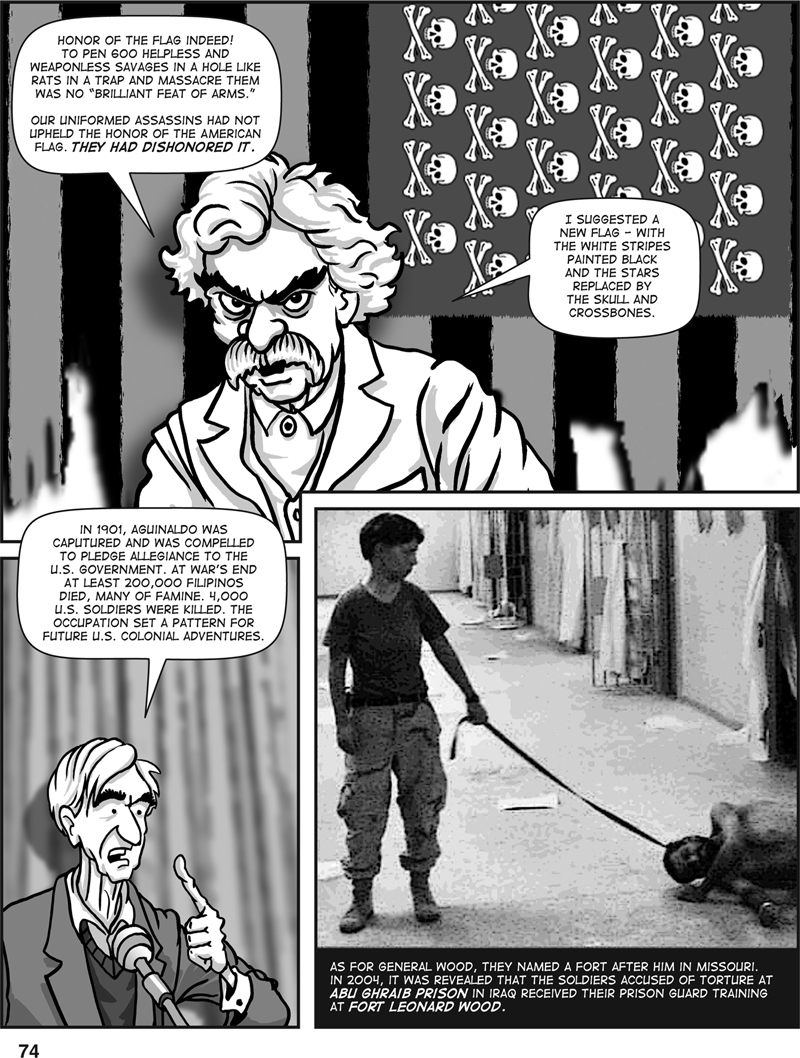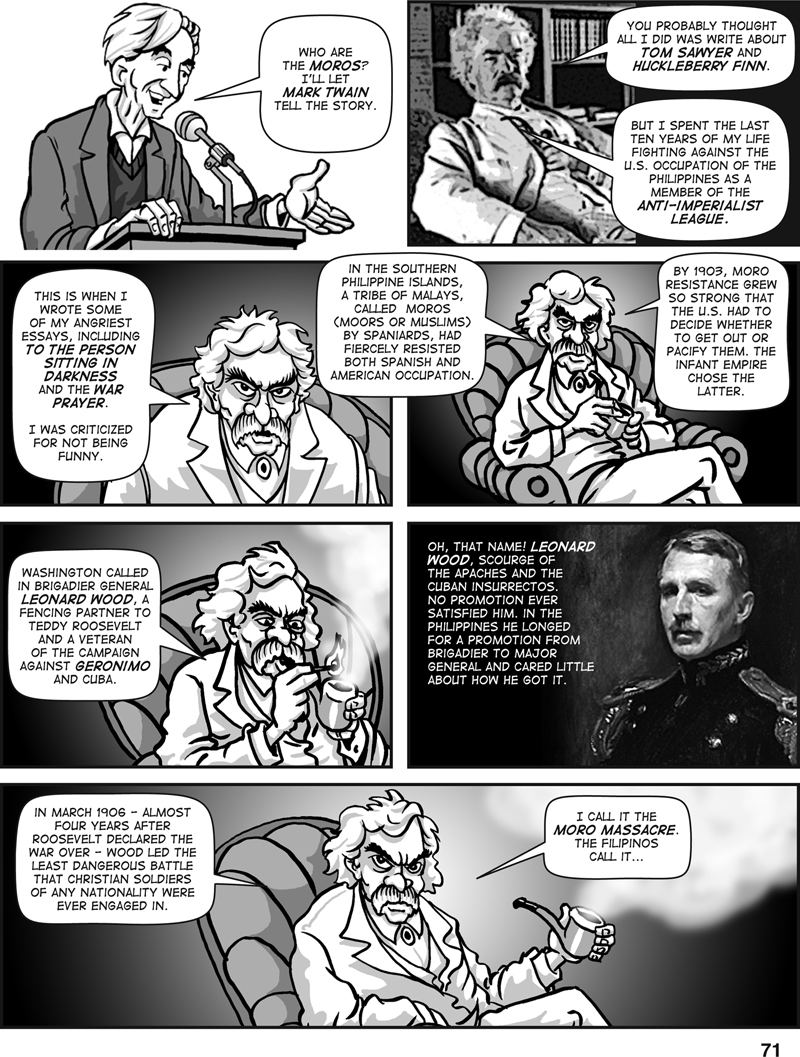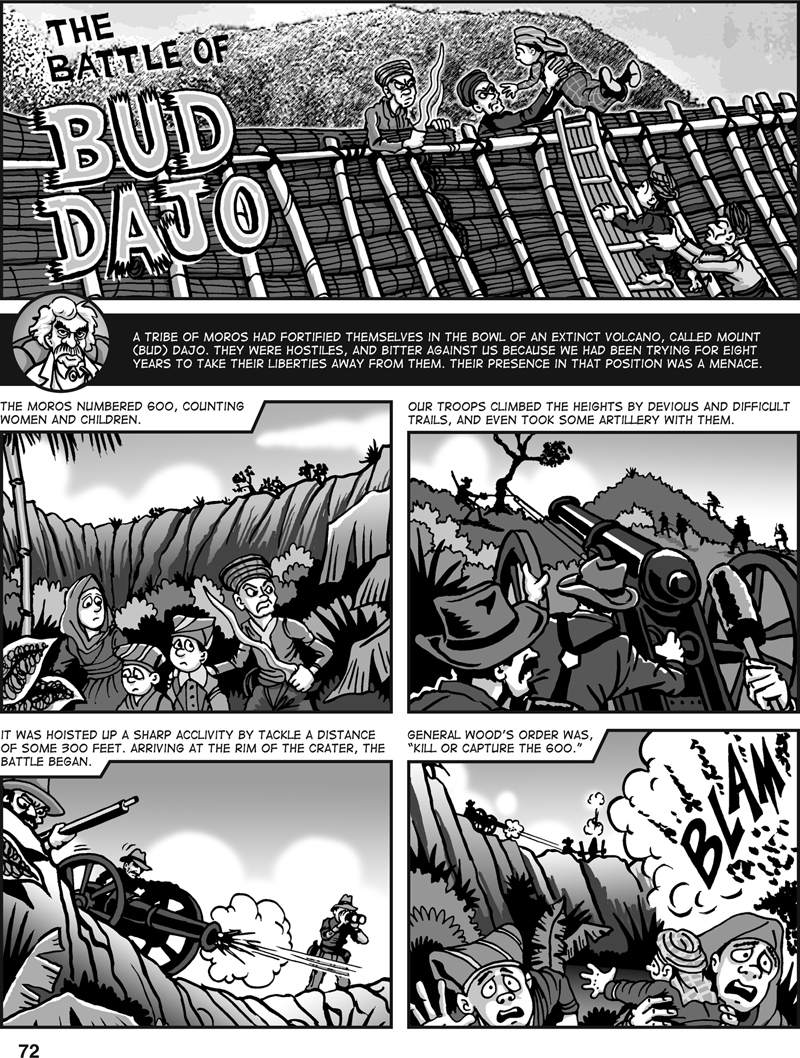 Labor and political cartoonist Mike Konopacki — close friend and collaborator of UE’s cartoonist Gary Huck — has produced a brilliant book-length graphic adaptation of a major portion of Howard Zinn‘s classic A People’s History of the United States. Created in collaboration with Zinn and historian Paul Buhle, Konopacki’s A People’s History of American Empire tells, in pictures and text, the story of U.S. government and corporate policies of controlling other people’s countries — from the seizure of the Philippines, Puerto Rico, and Cuba in the Spanish-American War, to George Bush’s invasion of Iraq. But it also shows that U.S. foreign policy is and always has been inseparable from domestic policies that have stolen land from and massacred Native Americans, crushed workers’ movements, and employed racism and immigrant bashing to divide and conquer working people.
Labor and political cartoonist Mike Konopacki — close friend and collaborator of UE’s cartoonist Gary Huck — has produced a brilliant book-length graphic adaptation of a major portion of Howard Zinn‘s classic A People’s History of the United States. Created in collaboration with Zinn and historian Paul Buhle, Konopacki’s A People’s History of American Empire tells, in pictures and text, the story of U.S. government and corporate policies of controlling other people’s countries — from the seizure of the Philippines, Puerto Rico, and Cuba in the Spanish-American War, to George Bush’s invasion of Iraq. But it also shows that U.S. foreign policy is and always has been inseparable from domestic policies that have stolen land from and massacred Native Americans, crushed workers’ movements, and employed racism and immigrant bashing to divide and conquer working people.
In 1980 Howard Zinn published A People’s History of the United States, a big but highly readable and engaging retelling of American history “from the bottom up.” In the standard textbooks most of us endured in school, “history” was something that was done by “great men,” and people like us were largely invisible. But in Zinn’s history, starting in 1492, Native Americans, sailors, slaves, immigrants, women, and other workers are at the center of things. Zinn’s book tells the truth about the misdeeds of the rulers — the ways they have attempted throughout our history to suppress democracy at home and to dominate other countries, all for the sake of greater corporate profit. He rebuts the official story line that U.S. government policy always advances “our national interest” and that its generous goals have been to “spread freedom and democracy.”
Zinn’s People’s History is now in its sixth edition, the latest version published in 2005. Each new edition updates the book with recent developments. It has sold 1.7 million copies and is now used as a textbook in many classrooms. By creating a comic book version that is very attractive and great fun to read, Konopacki will enable Howard Zinn’s important ideas about American history to reach an even larger audience.
Konopacki’s book is more personal than Zinn’s original. It makes Zinn the narrator, and Zinn tells us stories from his own life that help us better understand his view of history. In a chapter titled “Growing Up Class Conscious,” we see how Zinn’s thinking was shaped by his childhood in the slums of Brooklyn. He says of his father, “All his life he worked hard for very little. I’ve always resented statements of politicians, media commentators, corporate executives who talked of how in America, if you worked hard you would become rich. The meaning of that was, if you were poor, it was because you hadn’t worked hard enough.”
Later Zinn served in World War II as a bombardier in a B-17 Flying Fortress. Three weeks before the war in Europe ended, his plane and 1,200 other Flying Fortresses were sent on a strange mission, bombing an isolated German unit, no longer any military threat, holed up in the small western French village of Royan. It turns out that they were testing a new weapon — something then called “sticky fire,” later known in the Vietnam War as napalm. German soldiers and French civilians died horrible deaths from this bombing, and Zinn realized that he’d followed orders to commit an atrocity. He tells us how this event helped him discover that “the good war” to defeat fascism and save democracy was also, from the standpoint of the rulers of the United States, a war for profits and for empire.
Mike Konopacki’s wonderful art makes this book an irresistible read, and the stories and lessons it conveys make it unforgettable, and indispensable. Five years into Bush’s Iraq war — one of the most disastrous misadventures on the American Empire — America needs this book. — Al Hart
Mike Konopacki was exactly the right cartoonist to visually interpret Howard Zinn’s voice. Mike incorporates everything he’s learned in four decades of cartooning into each frame. As adept on the computer as he is with a brush and ink, the drawings in this book are masterful in their execution. Mike incorporates actual photos at key moments in the book to remind the readers that this is, after all, history. He also slyly incorporates photos and drawings together, giving the impression that history is emerging from behind the drawings, which of course it is. But outside of his profound skills as an artist, Mike has lived his professional life documenting people’s history as a labor cartoonist. He has been preparing for this moment since I first met him. I think you’ll agree — he was ready! — Gary Huck
 |
 |
 |
 |
Al Hart is the managing editor, and Gary Huck is the cartoonist, for the UE News, publication of the United Electrical, Radio and Machine Workers of America (UE). This review first appeared in the UE News‘ March issue.
